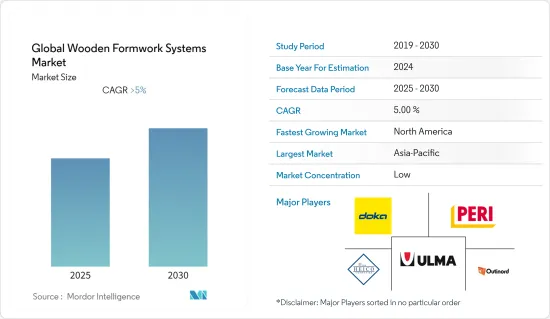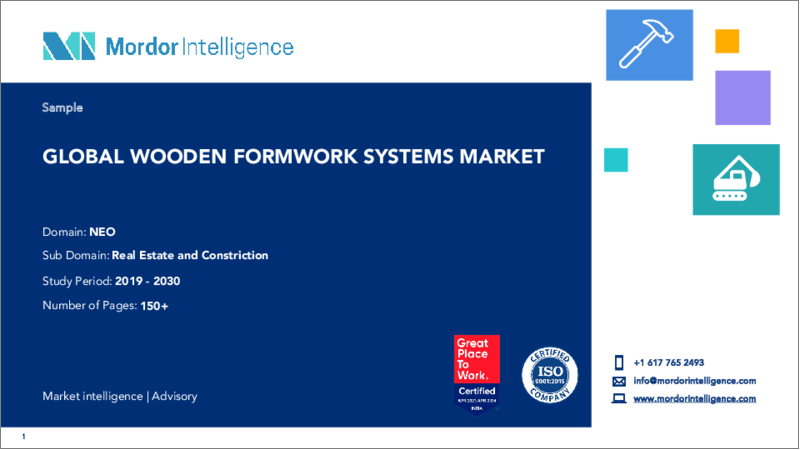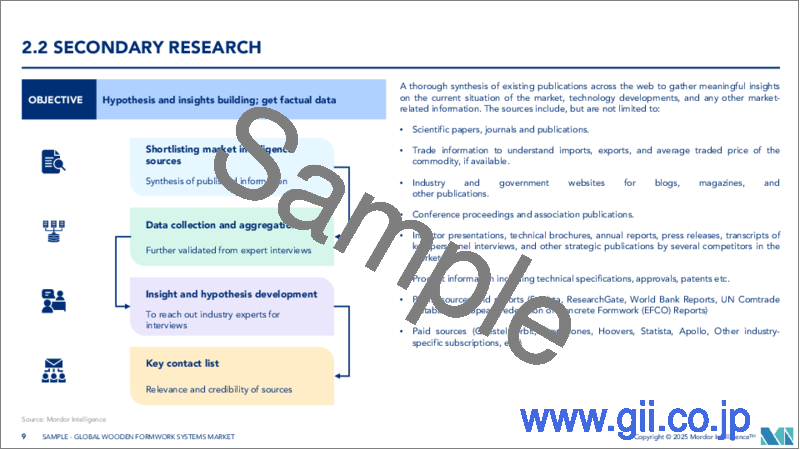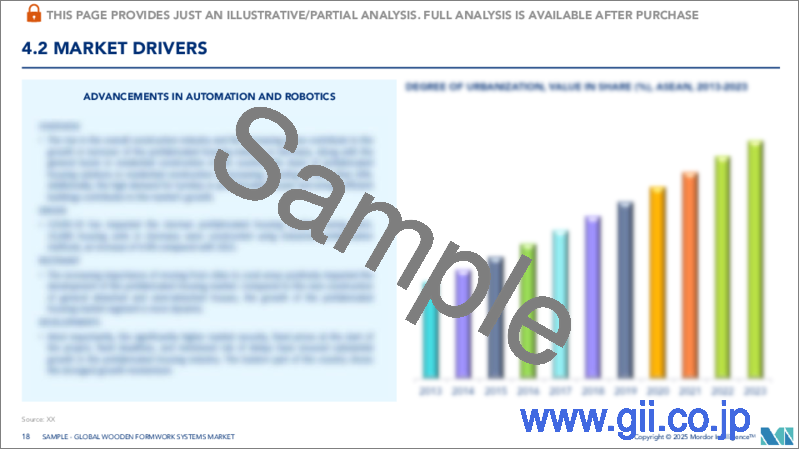|
|
市場調査レポート
商品コード
1632089
世界の木製型枠システム-市場シェア分析、産業動向・統計、成長予測(2025年~2030年)Global Wooden Formwork Systems - Market Share Analysis, Industry Trends & Statistics, Growth Forecasts (2025 - 2030) |
||||||
カスタマイズ可能
適宜更新あり
|
|||||||
| 世界の木製型枠システム-市場シェア分析、産業動向・統計、成長予測(2025年~2030年) |
|
出版日: 2025年01月05日
発行: Mordor Intelligence
ページ情報: 英文 120 Pages
納期: 2~3営業日
|
全表示
- 概要
- 目次
木造型枠システムの世界市場は予測期間中に5%以上のCAGRで推移する見込み

主要ハイライト
- COVID-19の発生は、不動産と建築建設、特に型枠システムで使用されるハードウェアに多くの問題を引き起こしました。ウイルスの蔓延を食い止めるために実施された封鎖措置は、建設サプライチェーンを停滞させました。
- これらのシステムは、型枠、クランプ、ジョイント、サポートなど、さまざまな部品で構成されています。合板や木製シャッターの方が安価で入手しやすいため、木製の型枠が多く使われています。
- 木製の型枠システムは、骨格やキャットウォークとも呼ばれ、木製の板や材木を使って仮設または常設の通路や骨格を作ります。型枠は、作業員を空から守り、建物の壁のレンガを打ち直したり、公益事業作業中にパイプを覆ったりするなど、施工が必要な面に作業員が安全に上がれるようにするために使用できます。
- チャイナモミは、大きさが変わらず、水が入らないため、市場で最も人気のあるタイプの滑り台です。しかし、建築産業からの需要が増えているため、木製のすべり台の市場は急速に拡大しています。パイン材を使用した滑り台の市場は、他の滑り台に比べて成長ペースが遅いと予想されます。地域別では、北米がすべり台市場をリードし、次いで欧州がリードしています。アジア太平洋は、インドや中国などの国々からの需要増加により、今後数年間で最も速い成長率を示すと予想されます。
木製型枠システム市場の動向
建設産業の成長が市場の需要を促進
今後数年間で、世界中の建設産業はより多くの資金を着実にもたらすと予想されます。2030年には2020年の2倍以上の規模になると予測されています。今後数年間は、新興市場での建築プロジェクトが増えるため、建設市場は成長する可能性が高いです。2022年3月、オーストラリア政府は予算を発表した際、国内のインフラプロジェクトにさらに179億豪ドル(約134億米ドル)を投じると約束しました。さらに、オーストラリア政府は水インフラ建設にさらに55億米ドル(約74億豪ドル)を投じると約束しました。パンデミックによる2年間の低迷を経て、2022年、インドの商業建設産業は力強い成長軌道に乗る。
建設会社はインド全土で数多くの真新しい商業建設プロジェクトを開始しています。マレーシアでは、主要インフラプロジェクトの復活と並行して、政府は第12次マレーシア計画の下、人々に手頃な価格の住宅を提供することも検討しています。その結果、いくつかの新しい住宅プロジェクトが承認されました。2022年6月には、Residensi Wilayah Keluarga Malaysiaプロジェクトのもと、約6万8,000戸の住宅が建設承認を受けました。特に、第12次マレーシア計画では、政府は国内で50万戸の手頃な価格の住宅を供給することを目指しています。
2022年2月、フランスは世界的に7つの重要インフラプロジェクトの建設で中国と提携する最初の国となりました。フランスと中国は、アフリカ、東南アジア、東欧全域で、17億米ドル相当の7つの重要インフラプロジェクトを共同で建設します。フランスは世界中の重要な建設プロジェクトに資金を投入しており、またフランス国内のインフラプロジェクトに他国が資金を投入するよう働きかけています。スイスは2022年5月、フランスのインフラプロジェクト、特にFrench Rhine Lineに投資する可能性があると述べました。サウジアラビアは、人々がマイホームを購入しやすくするため、国内のさまざまな地域で新しい住宅プロジェクトを多数開始しています。サウジアラビアは、少なくとも国民の3分の2が住宅を所有できるようにする戦略の一環として、リヤド、サウジアラビア西部のメディナ、紅海西部のジッダ港など7つの主要都市に15万戸の住宅を建設するプロジェクトを開始しました。ある産業団体によると、建設市場全体の規模は2021年に8兆2,000億米ドルで、2030年には14兆4,000億米ドルになると予想されています。この建築産業の大きな成長は、人々が木製型枠システムを購入したいと思う大きな理由となると考えられます。
環境への悪影響が市場に課題をもたらす可能性
世界中のほとんどの建築物に木造フレームが使用されているにもかかわらず、世界中で森林が伐採されています。世界中の人間社会は、何千年もの間、木材を建築材料として使用してきました。木材は生物学的に重要な唯一の建築材料であるため、私たちは当然、建築に木材を使うことは環境に良いと考える傾向にあります。実のところ、木材を使用することによる環境上の利点は一筋縄ではいかないです。木材は自然の産物であるが、乾燥や加工には大量のエネルギーが使用されます。
その多くは木そのものバイオマスから得ることができるが、そのためには工場への投資が必要であり、多くの小規模生産者に広く分散している産業では必ずしも可能ではないです。木材はまた、森林破壊の主要要因でもあります。世界の自然林から採取される木材の約3分の1は、木材製品に使用されています。森林減少の大部分を占める国々では、木材製品が全体の約10%を占めています。森林伐採と森林劣化は、気候変動と生物多様性の損失を引き起こす重要な要因であり、現代の2つの重要な環境課題です。森林、特に熱帯林は膨大な量の炭素を蓄積しています。森林が破壊されると、その炭素が大気中に放出され、地球温暖化を加速させる。
国連食糧農業機関(FAO)の推定によると、1990~2020年の間に4億2,000万ヘクタール、つまり欧州連合(EU)の面積よりも広い森林が森林破壊によって失われました。正味面積の損失(伐採された森林面積と新たに植林または再生された森林面積の差)で見ると、FAOは同じ期間に世界で約1億7,800万ヘクタールの森林が失われたと推定しており、これはフランスの3倍の面積に相当します。森林破壊は、熱を奪う総排出量の約10%を占めており、これは6億台の自動車が1年間に排出する量とほぼ同じです。建築に木材を使用することによるこの悪影響は、市場成長の抑制要因になる可能性があります。
スチールのような代替材料は環境に優しく、リサイクル可能で、長持ちします。伐採を減らし、森林を保護し、地球温暖化と温室効果を削減または阻止することができます。鉄骨型枠は建設廃棄物の削減に役立つ設置に多くの費用がかかるため、中小規模の建築業者には使用する余裕がない可能性があります。木材は入手しやすく、安価で扱いやすいです。一方、鋼材は溶接工や複雑な溶接設備が必要です。そのため、木材には悪い面もあるが、それでも建築産業、特に構造部門では多く使われています。
木製型枠システム産業概要
世界の木製型枠システム市場はセグメント化されており、競争が激しいです。競合と価格競争が激しくなり、新たな投資家やデベロッパーが市場に参入しています。さらに、木製型枠の需要と供給の両方が増加しています。市場で事業を展開する主要企業には、Doka、PERI、ULMA、Acro、The Heico Companies LLC、MEVA Systems Inc.などがあります。世界中で建設プロジェクトが増加しているため、新規参入企業が市場に参入しやすくなっています。それでも、こうした小規模参入企業は、既存の大手参入企業との熾烈な競合に直面しています。市場の大手参入企業は、他の参入企業に対して競合を持つために、幅広い製品を提供しています。新興企業は、革新的な製品と技術の統合によって市場に参入しようとしています。
その他の特典
- エクセル形式の市場予測(ME)シート
- 3ヶ月間のアナリストサポート
目次
第1章 イントロダクション
- 調査の前提条件と市場定義
- 調査範囲
第2章 調査手法
- 分析手法
- 調査フェーズ
第3章 エグゼクティブサマリー
第4章 市場力学と洞察
- 市場概要
- 市場促進要因
- 市場抑制要因
- 市場機会
- バリューチェーン/サプライチェーン分析
- 産業の魅力-ポーターのファイブフォース分析
- 買い手/消費者の交渉力
- 供給企業の交渉力
- 新規参入業者の脅威
- 代替品の脅威
- 競争企業間の敵対関係
- 政府の規制と施策
- このセグメントにおける技術開発
- COVID-19の市場への影響
第5章 市場セグメンテーション
- スライドタイプ別
- 中国モミ
- 木材
- 松材
- 合板
- 用途別
- 建物
- 輸送
- 産業施設
- 地域別
- 北米
- 欧州
- アジア太平洋
- 中東・アフリカ
- その他
第6章 競合情勢
- 市場集中概要
- 企業プロファイル
- Doka
- PERI
- ULMA
- Acrow
- The Heico Companies LLC
- Outinord
- MFE Formwork Technology Sdn.Bhd
- Urtim Formwork and Scaffolding Systems
- Waco International
- MEVA Systems Inc*
第7章 市場の将来
第8章 付録
The Global Wooden Formwork Systems Market is expected to register a CAGR of greater than 5% during the forecast period.

Key Highlights
- The COVID-19 outbreak caused a lot of problems in real estate and building construction, especially with the hardware used in formwork systems.The lockdowns that were put in place to stop the spread of the virus slowed down the construction supply chain.This hurt the market for wooden formwork systems, which led to less demand and less money for companies in the market.
- Most of this growth is due to more money being put into infrastructure projects and more construction projects being started.Formwork systems made of wood are used to control the shape and size of buildings as they are being built or rebuilt.These systems are composed of a number of different parts, including forms, clamps, joints, and supports. Most wooden formwork systems are made of wood because it is strong enough to stand up to the forces that are put on it during construction but also flexible enough to fit the shapes of buildings.Wooden formwork is more in use because plywood and wood shutters are cheaper and more accessible.
- Wooden formwork systems, also called scaffolds or catwalks, are made from wooden boards and timbers to make temporary or permanent walkways or scaffolds. The formwork can be used to protect workers from the sky and help them get up safely on a surface that needs to be built, like repointing the bricks in a building's wall or covering pipes while doing utility work, etc.
- China fir is the most popular type of slide on the market because it stays the same size and doesn't let water in. But the market for slides made of wood is growing faster because there is more demand from the building industry. The market for pine wood slide types is expected to grow at a slower pace as compared to other slide types due to a lack of awareness among buyers about its advantages. In terms of geography, North America leads the slide-type market, then Europe. Asia Pacific is expected to witness the fastest growth rate in the next few years owing to increased demand from countries such as India and China.
Wooden Formwork Systems Market Trends
Growing Construction Industry to Fuel the Demand in the Market
Over the next few years, the construction industry around the world is expected to steadily bring in more money. In 2030, it is projected to be more than twice as big as it was in 2020. Over the next few years, the construction market is likely to grow because there are more building projects in emerging markets. In March 2022, when the Australian government released its budget, it promised to spend another AUD 17.9 billion (USD 13.4 billion) on infrastructure projects in the country.In addition, the Australian government has promised to spend another USD 5.5 billion or AUD 7.4 billion on building water infrastructure.After a two-year slump caused by a pandemic, India's commercial construction industry is on a strong growth path in 2022.
Construction companies have started a number of brand-new commercial construction projects across India. Alongside the revival of key infrastructure projects in Malaysia, the government is also looking to provide people with affordable housing under the 12th Malaysia Plan. Consequently, several new housing projects have received approval in the country. In June 2022, nearly 68,000 homes received construction approval under the Residensi Wilayah Keluarga Malaysia project. Notably, under its 12th Malaysian Plan, the government aims to provide 500,000 affordable homes in the country.
In February 2022, France became the first country to partner with China in building seven key infrastructure projects globally. France and China will jointly build USD 1.7 billion worth of seven key infrastructure projects across Africa, Southeast Asia, and Eastern Europe. France is putting money into important building projects around the world, and the country is also trying to get other countries to put money into infrastructure projects in France. Switzerland said in May 2022 that it might invest in infrastructure projects in France, especially the French Rhine Line. Saudi Arabia has started a number of new housing projects in different parts of the country to make it easier for people to buy their own homes. As part of its strategy to boost the ownership of houses to at least two-thirds of the Kingdom's people, Saudi Arabia launched projects to build 150,000 houses in seven key cities, such as Riyadh, Medina in western Saudi Arabia, and the western Red Sea port of Jeddah. According to an industry group, the construction market as a whole was worth USD 8.2 trillion in 2021 and is expected to be worth USD 14.4 trillion by 2030. This huge growth in the building industry will be a big reason why people want to buy wooden formwork systems.
Negative Environmental Impact Might Create Challenges for the Market
Even though timber framing has been used in most buildings around the world, forests have been cut down all over the world. Human societies around the world have used timber as a building material for thousands of years. As wood is the only significant biological building material, we are naturally inclined to believe that using wood in construction is good for the environment. As a matter of fact, the environmental benefits of using timber are not straightforward: although it is a natural product, a large amount of energy is used to dry and process it.
Much of this can come from the biomass of the tree itself, but that requires investment in plants, which is not always possible in an industry that is widely distributed among many small producers. Wood is also a major driver of deforestation. About a third of the wood extracted from natural forests worldwide is used for timber products. In the countries that account for most of the deforestation, wood products contribute about 10% of the total. Deforestation and forest degradation are important drivers of climate change and biodiversity loss, the two key environmental challenges of our time. Forests, especially tropical forests, store enormous amounts of carbon. When forests are destroyed, that carbon is released into the atmosphere, accelerating global warming.
The Food and Agriculture Organization of the United Nations (FAO) estimates that 420 million hectares of forest - an area larger than the European Union - were lost to deforestation between 1990 and 2020. In terms of net area loss (the difference between the area of forest cleared and the new surface of forests planted or regenerated), the FAO estimates that the world lost around 178 million hectares of forest cover in the same period of time, which is an area triple the size of France. Deforestation accounts for around 10% of total heat-trapping emissions-roughly the same as the yearly emissions from 600 million cars. This negative impact of using wood in construction may become a restraint on market growth.
Alternatives like steel are better for the environment, can be recycled, and can last for a long time. They can cut down on logging, save forests, and reduce or stop global warming and greenhouse effects. Even though using steel formwork helps cut down on construction waste, it costs a lot to set up, so small and medium-sized building contractors may not be able to afford to use it. Timber is easy to get, cheap, and easy to work with. Steel, on the other hand, needs welders and complicated welding equipment. So, even though wood has some bad effects, it is still used a lot in the building industry, especially in the structural sector.
Wooden Formwork Systems Industry Overview
The global wooden formwork systems market is fragmented and highly competitive. Competition and pricing have increased strongly, and new investors and developers have entered the market. Moreover, both the demand and supply of wooden formwork are increasing. Some key players operating in the market include Doka, PERI, ULMA, Acro, The Heico Companies LLC, MEVA Systems Inc., etc. The increasing number of construction projects across the globe makes it easier for new players to enter the market. Still, these small players face fierce competition from established major players. The major players in the market mostly offer a wide range of products to have a competitive edge over other players. Start-ups try to break into the market with innovative products and technology integration.
Additional Benefits:
- The market estimate (ME) sheet in Excel format
- 3 months of analyst support
TABLE OF CONTENTS
1 INTRODUCTION
- 1.1 Study Assumptions and Market Definition
- 1.2 Scope of the Study
2 RESEARCH METHODOLOGY
- 2.1 Analysis Methodology
- 2.2 Research Phases
3 EXECUTIVE SUMMARY
4 MARKET INSIGHTS AND DYNAMICS
- 4.1 Market Overview
- 4.2 Market Drivers
- 4.3 Market Restraints
- 4.4 Market Opportunities
- 4.5 Value Chain / Supply Chain Analysis
- 4.6 Industry Attractiveness - Porter's Five Forces Analysis
- 4.6.1 Bargaining Power of Buyers/Consumers
- 4.6.2 Bargaining Power of Suppliers
- 4.6.3 Threat of New Entrants
- 4.6.4 Threat of Substitute Products
- 4.6.5 Intensity of Competitive Rivalry
- 4.7 Government Policies and Regulations
- 4.8 Technological Developments in the Sector
- 4.9 Impact of COVID-19 on the Market
5 MARKET SEGMENTATION
- 5.1 By Slide Type
- 5.1.1 China Fir
- 5.1.2 Timber
- 5.1.3 Pine Wood
- 5.1.4 Plywood
- 5.2 By Application
- 5.2.1 Buildings
- 5.2.2 Transportation
- 5.2.3 Industrial Facilities
- 5.3 By Geography
- 5.3.1 North America
- 5.3.2 Europe
- 5.3.3 Asia-Pacific
- 5.3.4 Middle-East and Africa
- 5.3.5 Rest of the World
6 COMPETITIVE LANDSCAPE
- 6.1 Market Concentration Overview
- 6.2 Company Profiles
- 6.2.1 Doka
- 6.2.2 PERI
- 6.2.3 ULMA
- 6.2.4 Acrow
- 6.2.5 The Heico Companies LLC
- 6.2.6 Outinord
- 6.2.7 MFE Formwork Technology Sdn.Bhd
- 6.2.8 Urtim Formwork and Scaffolding Systems
- 6.2.9 Waco International
- 6.2.10 MEVA Systems Inc*





